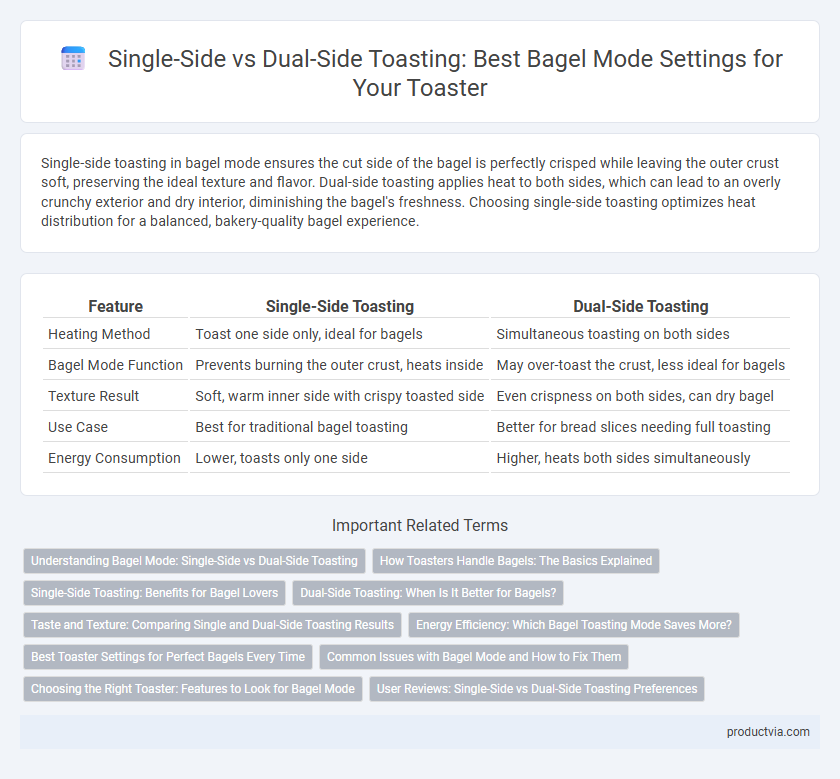Single-side toasting in bagel mode ensures the cut side of the bagel is perfectly crisped while leaving the outer crust soft, preserving the ideal texture and flavor. Dual-side toasting applies heat to both sides, which can lead to an overly crunchy exterior and dry interior, diminishing the bagel's freshness. Choosing single-side toasting optimizes heat distribution for a balanced, bakery-quality bagel experience.
Table of Comparison
| Feature | Single-Side Toasting | Dual-Side Toasting |
|---|---|---|
| Heating Method | Toast one side only, ideal for bagels | Simultaneous toasting on both sides |
| Bagel Mode Function | Prevents burning the outer crust, heats inside | May over-toast the crust, less ideal for bagels |
| Texture Result | Soft, warm inner side with crispy toasted side | Even crispness on both sides, can dry bagel |
| Use Case | Best for traditional bagel toasting | Better for bread slices needing full toasting |
| Energy Consumption | Lower, toasts only one side | Higher, heats both sides simultaneously |
Understanding Bagel Mode: Single-Side vs Dual-Side Toasting
Bagel mode on toasters is designed to toast the cut side of a bagel while warming the outer side, preserving its texture and flavor. Single-side toasting targets only the exposed interior, preventing the outer crust from burning and maintaining its chewiness. Dual-side toasting applies heat to both the cut and outer surfaces, offering a more evenly browned bagel but potentially compromising the traditional contrast between crisp and soft textures.
How Toasters Handle Bagels: The Basics Explained
Toasters with single-side toasting for bagel mode heat only the cut side of the bagel while gently warming the rounded crust, preserving its texture and preventing burning. Dual-side toasting toasters apply heat evenly to both sides, which may result in a crisper crust but can risk over-toasting the cut portion. Modern bagel settings often feature specialized heating elements and sensors to automatically adjust the toasting process, enhancing flavor and texture based on the toaster's design.
Single-Side Toasting: Benefits for Bagel Lovers
Single-side toasting in bagel mode ensures the cut side of the bagel is perfectly crisped while the outer crust remains soft and warm, preserving the bagel's texture and flavor. This method prevents over-toasting the rounded side, maintaining its chewy consistency essential for an authentic bagel experience. Ideal for bagel lovers, single-side toasting delivers a balanced combination of crunch and softness in every bite.
Dual-Side Toasting: When Is It Better for Bagels?
Dual-side toasting in bagel mode is ideal when a uniform crispiness is preferred, ensuring both the cut side and outer crust receive even heat. This method preserves the bagel's texture by preventing over-toasting on one side while delivering a balanced, golden finish. Dual-side toasting also enhances flavor by caramelizing the sugars on both surfaces, providing a richer taste experience compared to single-side toasting.
Taste and Texture: Comparing Single and Dual-Side Toasting Results
Single-side toasting in bagel mode enhances the texture by keeping the interior soft while crisply toasting the exposed surface, preserving the bagel's classic chewy bite. Dual-side toasting delivers a more uniform crunch with both sides being toasted, intensifying the flavor through Maillard reactions on both surfaces. This method often results in a firmer texture that some prefer for a richer, more robust taste experience.
Energy Efficiency: Which Bagel Toasting Mode Saves More?
Single-side toasting in bagel mode uses less energy by only heating one surface, reducing overall power consumption compared to dual-side toasting, which activates heating elements on both sides. Energy efficiency benefits from concentrating heat on the cut side where the bagel needs toasting, avoiding unnecessary energy use on the outer crust. This targeted heating approach results in faster toasting times and lower electricity usage, making single-side bagel mode the more energy-efficient choice.
Best Toaster Settings for Perfect Bagels Every Time
Single-side toasting in bagel mode heats only the cut side, ensuring a crispy texture while leaving the outer crust soft and warm, ideal for authentic bagel preparation. Dual-side toasting warms both sides evenly, which can lead to a more uniform texture but may reduce the signature chewy crust contrast. For perfect bagels every time, selecting single-side toasting with medium heat settings optimizes crispiness without over-toasting the exterior.
Common Issues with Bagel Mode and How to Fix Them
Bagel mode in toasters often causes uneven toasting due to single-side heating elements, leaving the outer side toasted while the inside remains soft. Dual-side toasting improves heat distribution by activating elements on both sides, ensuring consistent crispiness and preventing soggy textures. To fix common issues, clean toasted crumbs regularly and adjust browning settings to match bagel thickness for optimal results.
Choosing the Right Toaster: Features to Look for Bagel Mode
When selecting a toaster with a bagel mode, prioritize dual-side toasting to ensure both the cut and outer sides of the bagel are evenly browned, enhancing flavor and texture. Single-side toasting heats only the cut side, which may result in a less crispy outer crust. Look for toasters with adjustable browning settings and wider slots to accommodate various bagel sizes for optimal results.
User Reviews: Single-Side vs Dual-Side Toasting Preferences
User reviews reveal a strong preference for single-side toasting in bagel mode, highlighting its ability to perfectly crisp the cut side while gently warming the outer crust. Dual-side toasting often leads to overcooked or dry edges, diminishing the bagel's texture and flavor according to consumer feedback. Many users prefer single-side settings for achieving the ideal balance of softness and crunch in toasted bagels.
Single-side toasting vs dual-side toasting for bagel mode Infographic

 productvia.com
productvia.com